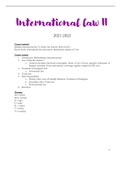Samenvatting
Samenvatting International Law VUB 21-22. Alle lessen aanwezig + vb examenvragen
- Instelling
- Vrije Universiteit Brussel (VUB)
Samenvatting International Law VUB 21-22. Alle lessen aanwezig + vb examenvragen gegeven door de prof op het einde van het semester vanachter in het document. Succes voor de examens xxx
[Meer zien]




